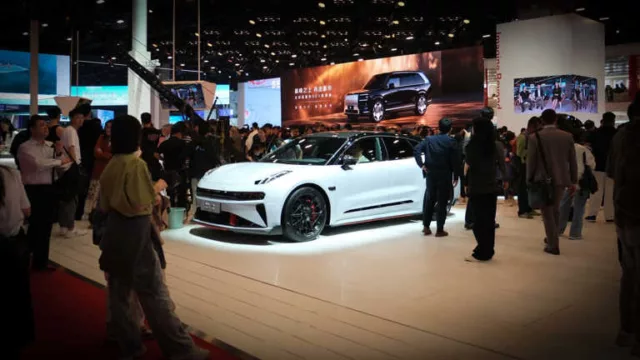
The world’s EV brands brought their A-game to China’s massive automotive expo. It almost didn’t matter that Tesla was MIA.
This week in Shanghai, close to one million people are expected to visit China’s biggest automotive exposition. They’ll be able to poke around in thousands of new cars as more than 1,000 different companies show off their latest models and updated technologies. They’ll see the latest and greatest from China’s own fast-moving car companies while Western brands like General Motors and Volkswagen scramble to keep up.
But they won’t see anything from Tesla.
As was the case at the last Shanghai Auto Show in 2023, the world’s biggest electric vehicle manufacturer is skipping out on the world’s biggest electric vehicle market. While China was still important enough to be the launch market for its most important vehicle, the updated «Juniper» Model Y, Tesla’s one-time dominance there is being called into question as new players offer a wider range of cars with even more advanced features.
tesla china delivery center
Tu Le, the founder and director of the research firm Sino Auto Insights, said that by skipping the show, Tesla may have missed a chance to build awareness and stave off some of the new Chinese EV competition. However, that would’ve required a glut of new products that it simply does not have.
«It’s not too surprising,» Le said. «They have nothing to show, and it would’ve been very difficult for them to stand out in any significant way. Tesla’s decline in China is a product (or lack thereof) issue.»
Tesla no longer responds to requests for comment from American news outlets. But its strategy at auto shows—large, regional events where automakers announce new products to the media and then allow the general public to get hands-on with their latest models—has been inconsistent for years. It showed off a prototype of the upcoming steering-wheel-free Cybercab at the LA Auto Show last year and hauled out the then-new Highland Model 3 at IAA Munich in 2023.
But that same year, Tesla also passed on China’s biggest auto show in Shanghai, despite having a factory nearby and the event being held in its second-largest car market. The 2023 Shanghai show was the first major international auto show in China since the COVID-19 pandemic lockdowns. It also served as a wake-up call to just how advanced the local EV market had become.
2025 Shanghai International Auto Show
None of that, of course, would’ve been possible without Tesla. As many people told InsideEVs during our trip to the Shanghai Auto Show, CEO Elon Musk and his company helped make EVs «cool» in China—but it also kickstarted a wave of local competition that took the Tesla template and ran with it. Today, many EVs in China can be charitably described as Tesla-like: made with advanced new manufacturing techniques, powered by connected software, and featuring a user interface centered around a large screen.
To be clear, Tesla maintains a strong presence in China and that has been reflected in its sales. But the new competition in China offers those kinds of features, and then some. An Onvo L60, from the automaker Nio, dramatically undercuts the Model 3 and Model Y in price. Other Nio models feature the increasingly popular battery-swapping feature. And BYD, which surpassed Tesla in EV production last year, showed off a pair of models with its new Megawatt charging, capable of adding about 250 miles of range in just five minutes.
Onvo L60 at the 2025 Shanghai International Auto Show
So while EV buyers in America and Europe are wondering where Tesla is on meeting such competitors, customers in China seem to be saying the same thing. And signs point to buyers there moving elsewhere, Le said.
«[Model Y] Juniper started deliveries in early January, so it’s only been out in the market for a couple of months, if we take January and some of February away because of Chinese New Year,» he said. «And they’ve already significantly given it a non-price price cut by offering five years’ interest-free just last week. That’s not a good sign for them for the rest of this year.»
Meanwhile, as Musk has staked Tesla’s future on autonomous driving, recent developments in China may put a damper on that dream. In March, three university students died when the Xiaomi SU7 they were in crashed into a concrete barrier moments after alerting the driver to take over from its automated driving assistance mode.
The crash has China and its auto sector on edge; indeed, it came up frequently at this year’s Shanghai show. As a result of the incident, China’s government has cracked down on the marketing of such systems to ensure people don’t believe they are truly «self-driving.» Yet this comes right as Musk continues to seek regulatory approval for Tesla’s Full Self-Driving system there.
So if Tesla has to compete in China, for now, it may be doing so on the merits of its cars alone—which potential customers didn’t get to see on the biggest stage possible.
Contact the author: patrick.george@insideevs.com
More China News
- Volvo EX30 Begins Very Timely Production In Europe
- The Buick Electra GS Concept Is A Stunning Way To Fight Back In China
- The Toyota bZ7 Looks Fantastic. Too Bad It’s Only For China
- The Nissan Frontier PHEV You Actually Want Is Here
- Chinese Cars Go From ‘Announced’ To ‘On The Road’ Very Quickly
- Zeekr 009 Special Edition Minivan Has Actual Gold Plating And 778 HP









